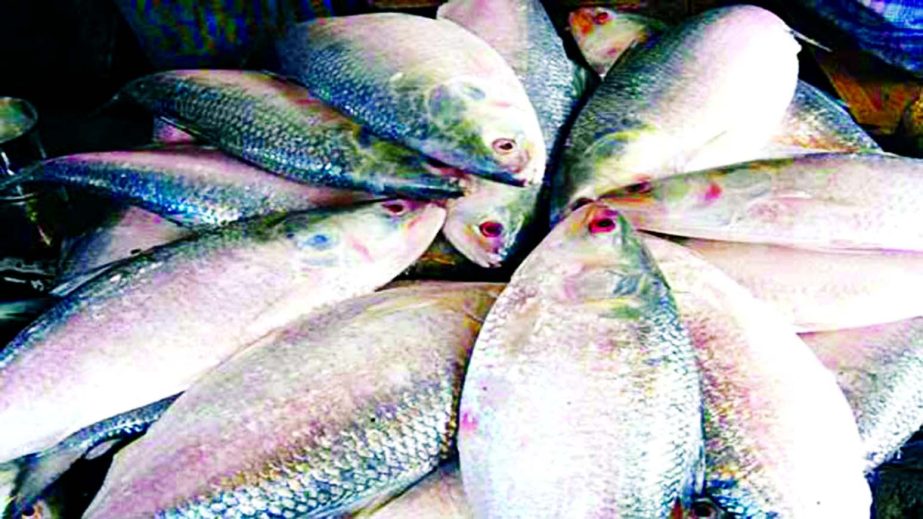
Staff Reporter :
The national fish Hilsa is going to get registration as the Geographical Indication [GI] product of Bangladesh.
Seeking the GI registration for the national fish, Director General of Department of Fisheries Dr Syed Arif Azad on Sunday submitted a formal application to the Ministry of Industries.
Senior Secretary of the Ministry of Industries Md. Mosharraf Hossain Bhuiyan received the application. “The government had recently taken some major steps to protect the intellectual property and rights on GI goods,” Bhuiyan said.
“With support from the World Intellectual Property Organisation [WIPO], necessary rules and regulation have also been formulated for ensuring registration of GI products and rights on them,” he said.
A GI is a name or sign used on certain products which corresponds to a specific geographical location or origin such as a town, region, or a country. The country will be able to protect better the origin of Hilsa and rights on it with the GI registration.
Officials said, Hilsa will be the second Bangladeshi GI registered produce after Jamdani. The government last month completed all process for getting GI registration for Jamdani, the classic Muslin craft and one of the finest textiles of the country.
The use of a GI may also act as a certification that the product possesses certain qualities, is made according to traditional methods, or enjoys a certain reputation, due to its geographical origin.
The GI enables those who have the right to use the indication to prevent its use by a third party whose product does not conform to the applicable standards.
Hilsa, the national fish of Bangladesh, is considered as one of the tastiest fishes due to its distinctly soft oily texture and superb mouthwatering flavor. In course of time, it becomes a part of Bengali tradition. For its elegancy, it is also locally called king of fish [machher raja].
Hilsa is not just a craze in Bangladesh, it is also an integral part of local tradition. This species of fish is also found in 12 Asian countries – from Kuwait and Bahrain in the west through Pakistan, India, Bangladesh, Myanmar, Thailand, Malaysia, Indonesia, Cambodia, Vietnam and China in the east.
The national fish Hilsa is going to get registration as the Geographical Indication [GI] product of Bangladesh.
Seeking the GI registration for the national fish, Director General of Department of Fisheries Dr Syed Arif Azad on Sunday submitted a formal application to the Ministry of Industries.
Senior Secretary of the Ministry of Industries Md. Mosharraf Hossain Bhuiyan received the application. “The government had recently taken some major steps to protect the intellectual property and rights on GI goods,” Bhuiyan said.
“With support from the World Intellectual Property Organisation [WIPO], necessary rules and regulation have also been formulated for ensuring registration of GI products and rights on them,” he said.
A GI is a name or sign used on certain products which corresponds to a specific geographical location or origin such as a town, region, or a country. The country will be able to protect better the origin of Hilsa and rights on it with the GI registration.
Officials said, Hilsa will be the second Bangladeshi GI registered produce after Jamdani. The government last month completed all process for getting GI registration for Jamdani, the classic Muslin craft and one of the finest textiles of the country.
The use of a GI may also act as a certification that the product possesses certain qualities, is made according to traditional methods, or enjoys a certain reputation, due to its geographical origin.
The GI enables those who have the right to use the indication to prevent its use by a third party whose product does not conform to the applicable standards.
Hilsa, the national fish of Bangladesh, is considered as one of the tastiest fishes due to its distinctly soft oily texture and superb mouthwatering flavor. In course of time, it becomes a part of Bengali tradition. For its elegancy, it is also locally called king of fish [machher raja].
Hilsa is not just a craze in Bangladesh, it is also an integral part of local tradition. This species of fish is also found in 12 Asian countries – from Kuwait and Bahrain in the west through Pakistan, India, Bangladesh, Myanmar, Thailand, Malaysia, Indonesia, Cambodia, Vietnam and China in the east.

